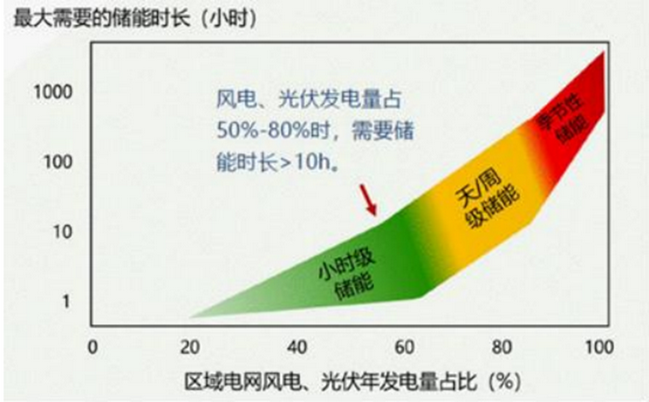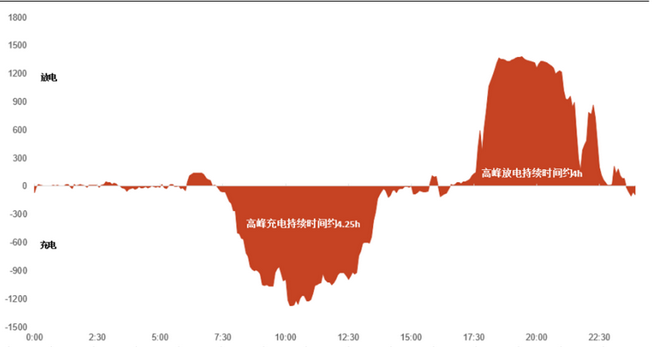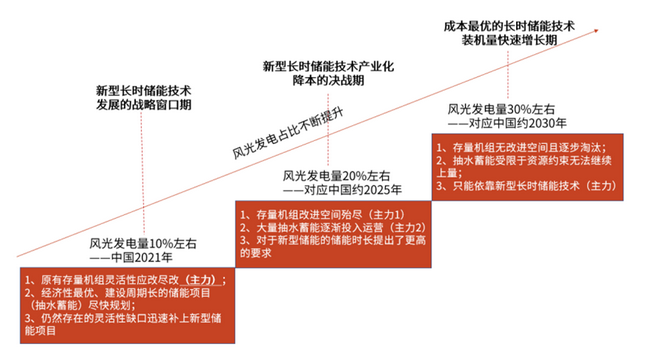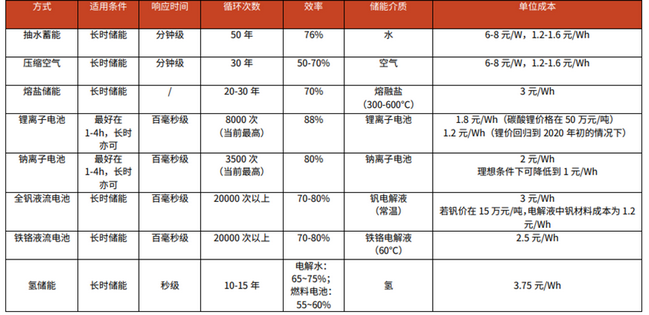| What is long-term energy storage? How economical is it? |
| Release time:2022-12-23 11:01:09| Viewed:177 |
What is long-term energy storage? How economical is it?
Long term energy storage generally refers to energy storage technology that lasts more than 4 hours. Long term energy storage system is an energy storage system that can realize cross day, cross month, and even cross season charging and discharging cycles to meet the long-term stability of the power system. The higher the penetration rate of renewable energy generation, the longer the energy storage time is required.
Renewable energy power generation is intermittent. The main power generation periods and peak power consumption periods are misaligned, and there is a gap between supply and demand. With the increase of permeability, the load requirement of balancing power system increases. Compared with short-term energy storage, long-term energy storage system can better realize power translation, transfer the power of renewable energy generation system to the peak time of power demand, and play the role of balancing the power system and large-scale power storage.
The higher the proportion of wind power and photovoltaic power generation, the longer the energy storage time
The function of peak shaving and valley filling of energy storage equipment is prominent, and the long-term energy storage equipment represented by 4h is necessary for development. According to the CAISO data, draw the charging and discharging curve of the single day battery energy storage equipment in the summer of 2021 in California.
It can be seen from the figure that the energy storage equipment stores electric energy at high power during the day, and discharges at high power during the peak of power consumption at night, with the peak discharge duration exceeding 4h.
Charging and discharging curve of single day battery energy storage equipment in summer in California
According to the research report of Strategen, solar energy will become the most important renewable energy in California by 2045, accounting for 75%. In order to balance solar power generation, it is necessary to store 8 to 12 hours of electric energy in the daytime, and the amount of storage and scheduling in the evening will also increase. At most, it needs to discharge continuously for 12 hours, so the development of long-term energy storage is indispensable.
Due to the high proportion of renewable energy generation, California is one of the first places to deploy a large number of energy storage systems with a continuous discharge time of 4 hours.
Since 2019, 4-hour energy storage systems have been deployed in California. According to Strategen's prediction, California will deploy 2-11GW of long-term energy storage equipment by 2030, and will achieve 45-55GW of long-term energy storage configuration by 2045.
Lithium battery energy storage projects in California for more than 4h Three stages of long-term energy storage For long-term energy storage, the most important thing is to provide support for flexible regulation of power system. In general, in the power system, the demand side of flexible resources is mainly wind and photovoltaic power generation facilities; The flexibility of power system mainly comes from two aspects, one is the flexible power generation of the original generator set, the other is the configuration of energy storage facilities.
When analyzing the pace of promotion, we simplified the flexibility provider into three parts: stock units; Mature energy storage mode - pumped storage; New energy storage technology. In this way, we can roughly outline the pace of energy storage with the gradual increase of the proportion of wind power generation.
It can be divided into three stages:
Phase 1: the level of about 10% of wind power generation (corresponding to the stage of China around 2021):
The strategic window period for the development of new long-term energy storage technology At this stage, the existing generator sets (coal power, gas power) can be transformed to provide more flexible resource support; Because of the long construction period (6-8 years) of traditional energy storage, pumped storage needs to be planned as soon as possible; The cost of new energy storage projects is still too high, but if there is still a flexibility gap, new energy storage projects need to be made up as soon as possible.
Phase 2: the level of about 20% of wind power generation (corresponding to the stage around 2025 in China):
The decisive period for the industrialization of new long-term energy storage technology to reduce costs is at this stage, and the transformation of existing generator sets is basically completed, which cannot provide more incremental flexibility; Pumped storage projects have been gradually completed, becoming the main force for flexible regulation together with the existing units; At this time, the demand for new energy storage is further enhanced.
Phase 3: the level of about 30% of wind power generation (corresponding to the stage of China in 2030 and the stage of California in 2020):
During the period of rapid growth of the installed capacity of long-term energy storage technology with optimal cost, there is no room for improvement and the stock units are phased out; Pumped storage cannot continue to increase due to geographical resource constraints; Only new long-term energy storage technology can provide incremental flexibility resources.
Promotion rhythm of long-term energy storage
Classification of long-term energy storage
The characteristics and cost reduction of energy storage technology are different. According to the different application scenarios, the long-term energy storage technology will present a pattern of simultaneous development of multiple lines.
Generally speaking, long-term energy storage technology can be divided into three main lines: mechanical energy storage, thermal energy storage and chemical energy storage. Among them, mechanical energy storage includes pumped storage and compressed air storage; The thermal storage is mainly molten salt thermal storage; Chemical energy storage includes lithium ion battery energy storage, sodium ion battery energy storage and liquid flow battery energy storage.
Comparison of energy storage technology routes
Economy Initial investment cost, energy storage efficiency and cycle life are the three core factors
Considering the charging cost, the pumped storage and compressed air energy storage technologies are the most economical, while the lithium ion battery energy storage technology is the electrochemical energy storage technology with the lowest electricity cost at this stage, and the sodium ion battery and liquid flow battery have higher electricity cost.
KWh cost in the whole life cycle of five energy storage forms (yuan/kWh)
2. Compressed air: when the efficiency is increased to 65%, the economy is expected to exceed that of pumped storage
With the improvement of energy storage efficiency, the cost per kilowatt hour of compressed air energy storage technology will continue to decline, which is expected to surpass pumped storage and become the most economical large-scale energy storage technology. The sensitivity analysis shows that when the initial investment cost is 1.4 yuan/Wh, assuming that the energy storage efficiency is increased to 70%/75%/80%, the electricity cost per kilowatt hour can be reduced to 0.834/0.806/0.782 yuan/kWh considering the charging price.
At present, the design efficiency of Zhangjiakou 100MW/400MWh advanced compressed air energy storage system has reached 70.4%, and its operation will be continuously observed.
Sensitivity analysis of "electricity cost per kilowatt hour" to initial investment cost and energy storage efficiency in compressed air energy storage (yuan/kWh)
3. Lithium ion battery: After the lithium price falls, the long-term energy storage scheme is still relatively economical. With the acceleration of industrialization and the fall of raw material prices, the initial investment cost of lithium ion energy storage is expected to gradually decline, which will improve its energy storage economy. According to the sensitivity analysis, when the energy storage efficiency is 88%, assuming that the initial investment cost of the 10MW/50MWh lithium-ion battery energy storage system is reduced to 1.5/1.2/1.0 (yuan/Wh), the electricity cost per kilowatt hour considering the charging price is 1.081/0.966/0.890 yuan/kWh.
Sensitivity analysis of "kilowatt hour cost" to initial investment cost and energy storage efficiency in lithium battery energy storage (yuan/kWh)
4. Liquid flow battery: initial investment cost and energy storage efficiency are two major constraints. With the acceleration of industrialization, the initial investment cost of liquid flow battery energy storage is expected to decrease, and its energy storage efficiency will gradually increase, which will further improve the cost of electricity per kilowatt hour of liquid flow battery.
According to the sensitivity analysis, when the energy storage efficiency is 75%, assuming that the initial investment cost of the 10MW/50MWh liquid flow battery energy storage system is reduced to 2.5/2.0/1.5 (yuan/Wh), the cost per kilowatt hour considering the charging price will be reduced to 1.293/1.132/0.971 yuan/kWh.
Sensitivity analysis of "electricity cost per kilowatt hour" to initial investment cost and energy storage efficiency in liquid flow battery energy storage (yuan/kWh)
5. Sodium ion battery: after the extreme cost reduction, it can be used as an economical long-term energy storage scheme. With the acceleration of industrialization, the initial investment cost of sodium ion battery energy storage is expected to gradually decrease, greatly improving its energy storage economy.
According to the sensitivity analysis, when the energy storage efficiency is 80%, assuming that the initial investment cost of the 10MW/50MWh sodium ion battery energy storage system is reduced to 1.6/1.3/1.0 (yuan/Wh), the electricity cost per kilowatt hour considering the charging price is 1.263/1.153/1.044. yuan/kWh. When the initial investment cost drops to 1.3 yuan/Wh, the cost per kilowatt hour will be lower than the current lithium ion battery.
In sodium electric energy storage, sensitivity analysis of "electricity cost per kilowatt hour" to initial investment cost and energy storage efficiency (yuan/kWh)
|













